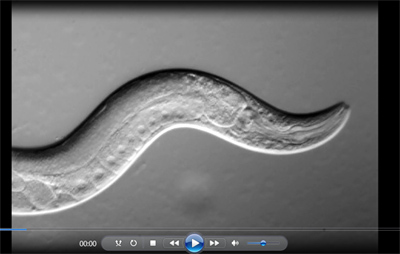A study analyzes the search behaviour of the worm C.elegans. An in-depth knowledge about the search strategy and how animals can locate objects can be very useful in developing more efficient algorithms for rescue operations or search robots.
 What is the best search strategy when we have neither information nor cues of the environment? A study about the search behaviour of the worm C.elegans demonstrate that the best strategy is to trust the expectations that one has about the environment together with some constant dose of random search. The study has been led by scientists Liliana C.M. Salvador, who was at the CSIC's Centre d'Estudis Avançats de Blanes (CEAB-CSIC) when the study was carried out and now is at the University of Glasgow (UK), and Frederic Bartumeus, scientist from the CSIC's Centre d'Estudis Avançats de Blanes and associated to CREAF. The study has also the contribution of the scientists Simon A. Levin from Princeton University (USA), and William S. Ryu from Toronto University (Canada).
What is the best search strategy when we have neither information nor cues of the environment? A study about the search behaviour of the worm C.elegans demonstrate that the best strategy is to trust the expectations that one has about the environment together with some constant dose of random search. The study has been led by scientists Liliana C.M. Salvador, who was at the CSIC's Centre d'Estudis Avançats de Blanes (CEAB-CSIC) when the study was carried out and now is at the University of Glasgow (UK), and Frederic Bartumeus, scientist from the CSIC's Centre d'Estudis Avançats de Blanes and associated to CREAF. The study has also the contribution of the scientists Simon A. Levin from Princeton University (USA), and William S. Ryu from Toronto University (Canada).
According to the theory, there are different ways to find what one is looking for: to make a planned search based on expectations developed from previous environmental experiences or to make a search based on random movements.
A study published in the Journal of the Royal Society Interface journal shows that when animals have no environmental information they use their memory to reproduce the movements they learned in previous experiences. Also, they combine their memories with a random search strategy, which gets progressively more relevant as memory decays.
“Our results allow us to demonstrate that animals usually search in an organized way when they know that what they are looking for is fairly near, or when they have a well defined mental map to rationally distribute the effort (in the case of animals with cognitive capacities). In contrast, when animals have no cues to follow, they base their search on their expectations of the environment and on the use of memory, which they combine with a random search strategy”, points out Frederic Bartumeus, ICREA research professor and leading scientist of the Movement Ecology Laboratory. According to Bartumeus, one of the results of this study shows that when random movements are added to a search process the probabilities of finding what one is seeking are higher.
A worm model to study the best strategy to find lost objects
To obtain the results for this study, an international and multi-disciplinary team has analyzed with a high level of detail the movement and the behaviour of the nematode Caenorhabditis elegans in a controlled laboratory environment. While searching, C.elegans combines forward movement with several well-known turns, which can be perfectly differentiated and individually studied: omega, reversals, and pirouettes turns, where, respectively, the worm turns by bending its body, turns by starting to crawl backwards, and turns combining the two previous behaviours into just one.
 “The advantage of C.elegans, a small nematode which is one of the most used laboratory models, is that we can simultaneously study its movement and its behaviour in real time. C. elegans, while moving, performs very visible turning behaviours, and each one of them has a specific role in the direction of motion. This is why it is very easy to see which turning behaviour the animal is making and, therefore, which direction it wants to take: there is no chance to mistake or misinterpret its movements, which enable us to accurately characterize the search strategy being used”, explains Liliana C. M. Salvador, currently at the University of Glasgow (UK).
“The advantage of C.elegans, a small nematode which is one of the most used laboratory models, is that we can simultaneously study its movement and its behaviour in real time. C. elegans, while moving, performs very visible turning behaviours, and each one of them has a specific role in the direction of motion. This is why it is very easy to see which turning behaviour the animal is making and, therefore, which direction it wants to take: there is no chance to mistake or misinterpret its movements, which enable us to accurately characterize the search strategy being used”, explains Liliana C. M. Salvador, currently at the University of Glasgow (UK).
As a matter of fact, an in-depth knowledge about the search strategy and how animals can locate objects when there is no information can be very useful in developing more efficient search algorithms, which can be used for rescue or military operations, where search robots look for subjects or substances.
This worm is a nematode that has already been very used in both biology and medical research. Yet, this work opens up new research possibilities such as the use of genetically modifiable organisms to study the interaction between organisms and their environment under an ecological perspective.
This work has been funded by the Spanish Ministry of Economy and Competitiveness, and by the Human Frontier Science Program (HFSP).
Salvador LCM, Bartumeus F, Levin SA, Ryu WS. 2014 Mechanistic analysis of the search behaviour of Caenorhabditis elegans. J. R. Soc. Interface 20131092. http://dx.doi.org/10.1098/rsif.2013.1092
